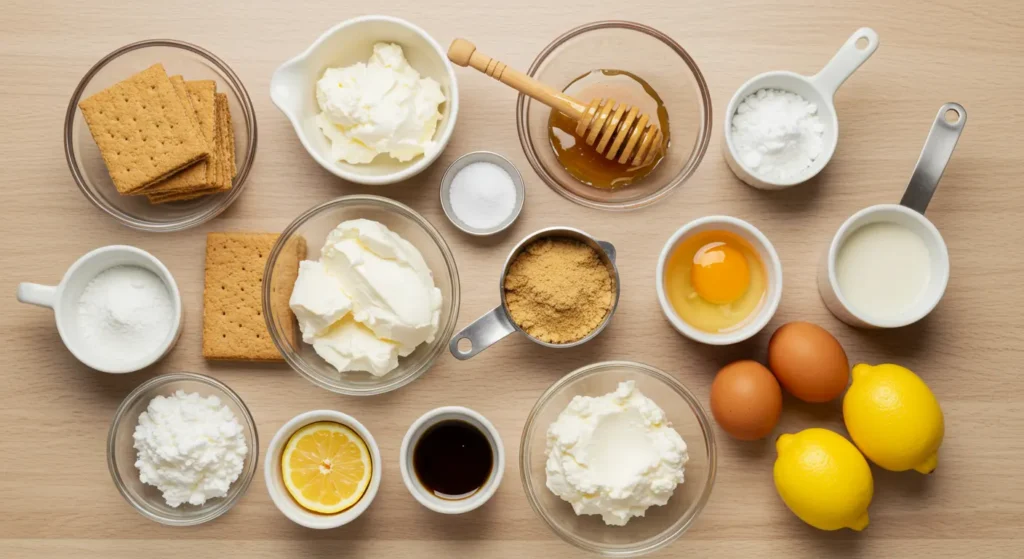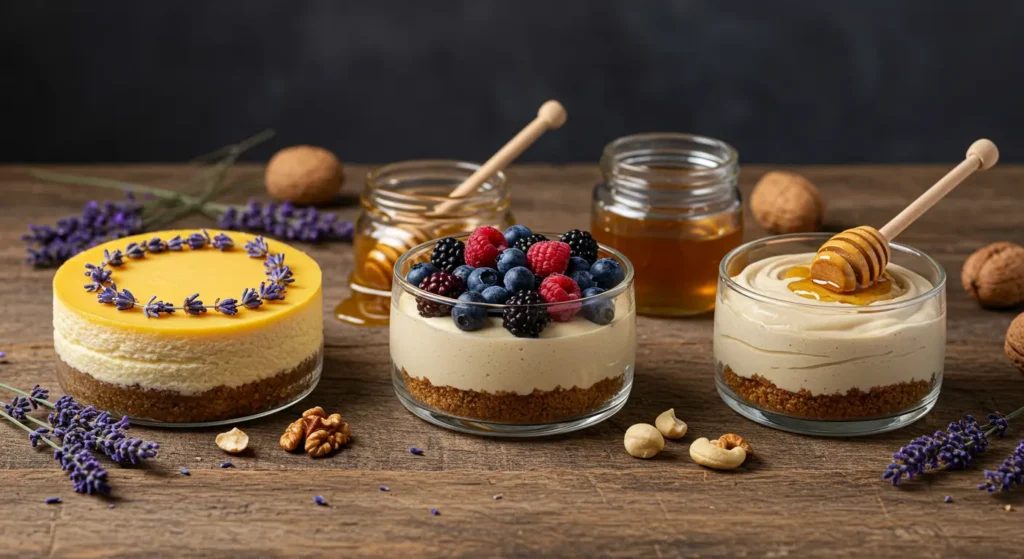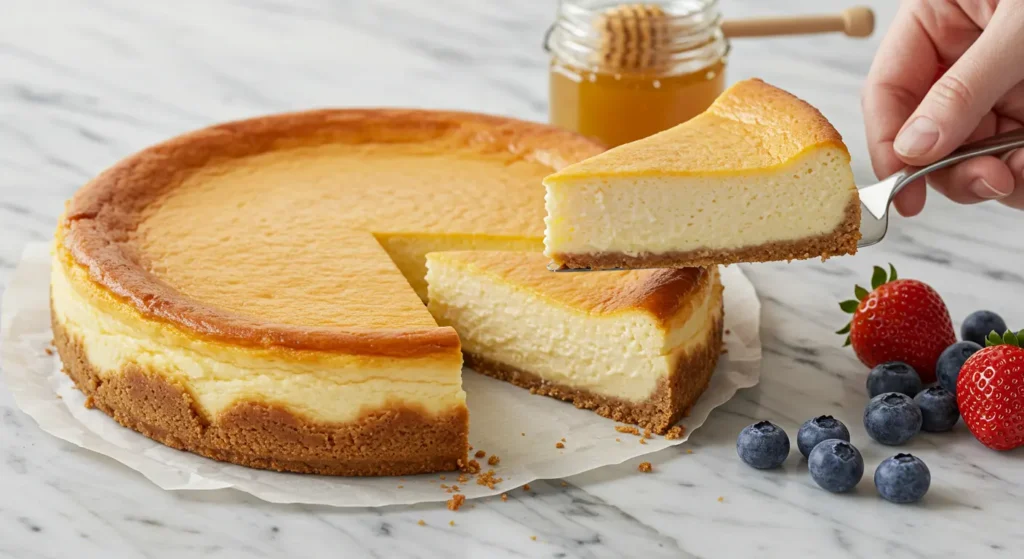Sweet Honey Dessert – Why This Recipe?
As Chef Greeny, my journey with honey-based desserts began during a transformative summer in the Greek countryside. The golden afternoon sun filtering through olive trees as my host, Yiayia Maria, showed me how to drizzle locally harvested honey over warm baklava remains one of my most treasured culinary memories.
What makes these sweet honey dessert recipes special isn’t just their incredible flavors but the way honey transforms ordinary ingredients into extraordinary treats. Unlike refined sugar, honey brings complex floral notes, varying sweetness levels, and valuable nutrients to your desserts.
In this comprehensive guide, you’ll discover my perfected honey cheesecake recipe—a delicate balance of creamy cheese, aromatic honey, and a buttery graham cracker crust that has become my signature dessert at family gatherings. I’ll share my secret technique for incorporating honey without overwhelming other flavors and provide variations for different dietary needs.
By the end of this article, you’ll have mastered a versatile honey dessert that impresses guests while being surprisingly simple to prepare.
Sweet Honey Dessert – Ingredients and Preparation
Ingredients List
For the crust:
- 2 cups graham cracker crumbs (about 16 full crackers)
- 6 tablespoons unsalted butter, melted
- 3 tablespoons high-quality honey
- 1/4 teaspoon sea salt
For the filling:
- 24 ounces cream cheese, room temperature
- 2/3 cup wildflower honey (or your favorite variety)
- 3 large eggs, room temperature
- 1 teaspoon vanilla extract
- 1/4 cup Greek yogurt
- 2 tablespoons all-purpose flour
- Zest of one lemon
For the honey glaze:
- 1/4 cup honey
- 2 tablespoons water
- 1 teaspoon lemon juice
- Fresh berries and mint leaves for garnish (optional)
Substitution options:
- For gluten-free: Use gluten-free graham crackers or almond flour cookie crust
- For dairy-free: Substitute plant-based cream cheese and coconut yogurt
- Honey variations: Try buckwheat honey for a deeper flavor or orange blossom honey for citrus notes
Step-by-Step Instructions
- Prepare the pan and oven: Preheat your oven to 325°F (165°C). Wrap the outside of a 9-inch springform pan with aluminum foil to prevent water from seeping in during baking. Tip: Use extra-wide foil and create at least two layers for proper water protection.
- Make the crust: In a medium bowl, combine graham cracker crumbs, melted butter, honey, and salt until the mixture resembles wet sand. Press firmly into the bottom and slightly up the sides of the prepared pan. Tip: Use the bottom of a measuring cup to create an even, compact layer.
- Pre-bake the crust: Bake for 10 minutes until lightly golden. Remove from oven and let cool while preparing the filling. Tip: Don’t skip this step—pre-baking ensures a crisp, not soggy, crust.
- Prepare the filling: In a large bowl, beat cream cheese on medium speed until completely smooth, about 3 minutes. Tip: Scrape down the sides of the bowl frequently to ensure no lumps remain.
- Add the honey: Pour in the honey and continue beating until fully incorporated. The mixture should be silky smooth. Tip: Warm your honey slightly if it’s too thick to incorporate easily.
- Incorporate eggs: Add eggs one at a time, beating just until incorporated after each addition. Overbeating will introduce too much air into the batter. Tip: Crack eggs into a separate bowl first to avoid shell fragments.
- Complete the batter: Add vanilla, Greek yogurt, flour, and lemon zest. Mix on low speed just until combined. Tip: The flour helps stabilize the cheesecake and prevent cracking.
- Pour and prepare for baking: Pour the filling over the cooled crust. Place the springform pan in a larger roasting pan. Fill the roasting pan with hot water until it reaches halfway up the sides of the springform pan.
- Bake the cheesecake: Bake for 55-65 minutes, until the edges are set but the center still has a slight jiggle. Tip: The cheesecake will continue firming up as it cools.
- Cool gradually: Turn off the oven, crack the door open, and let the cheesecake cool in the oven for 1 hour. This prevents cracks from sudden temperature changes.
- Prepare the glaze: In a small saucepan, combine honey, water, and lemon juice. Warm over low heat until thin and pourable, about 2 minutes.
- Finish and chill: Remove cheesecake from oven and water bath. Run a knife around the edges to loosen from the pan. Pour warm honey glaze over the top, spreading to cover evenly. Refrigerate for at least 4 hours, preferably overnight.
Notes and Tips
- Storage: This sweet honey dessert keeps well in the refrigerator for up to 5 days. Cover loosely with plastic wrap once completely cooled.
- Freezing: For longer storage, freeze individual slices wrapped in plastic and stored in airtight containers for up to 3 months.
- Make ahead: Prepare this cheesecake up to two days before serving. The flavors actually improve with time.
- Serving suggestion: Allow the cheesecake to sit at room temperature for 30 minutes before serving for optimal texture and flavor.
- Portion control: For elegant presentation, dip a sharp knife in hot water and wipe clean between cuts.
Sweet Honey Dessert – Nutritional Information
Nutrition Facts (Per Serving, based on 12 servings)
| Nutrient | Amount |
|---|---|
| Calories | 425 |
| Carbohydrates | 38g |
| Protein | 7g |
| Total Fat | 28g |
| Saturated Fat | 16g |
| Unsaturated Fat | 9g |
| Trans Fat | 0g |
| Fiber | 0.5g |
| Sugar | 29g |
| Cholesterol | 125mg |
| Sodium | 320mg |
“Honey adds not just sweetness but complexity to desserts. Its natural enzymes, antioxidants, and flavor compounds create depth that refined sugar simply cannot match.” – Chef Greeny
Sweet Honey Dessert – History and Cultural Significance
Sweet honey desserts have been delighting palates since ancient times, with evidence of honey harvesting dating back to 8,000 years ago. The ancient Egyptians used honey in their baked goods as offerings to their deities, while the Greeks considered it the “food of the gods” and used it extensively in their pastries.
The cheesecake itself has a fascinating history, with the earliest recorded mention found in Greece around 776 BCE. Athletes competing in the Olympic Games were served cheesecakes made with honey as an energy source. The Romans later adapted the recipe, adding eggs and baking it into something closer to what we enjoy today.
In many cultures, honey symbolizes prosperity, sweetness, and fertility. Jewish tradition serves apples dipped in honey during Rosh Hashanah to symbolize wishes for a sweet new year. Middle Eastern desserts like baklava bathe layers of phyllo dough and nuts in honey syrup, while Indian traditions incorporate honey into sweets like Gulab Jamun.
My honey cheesecake recipe represents this global heritage while adding modern techniques and balanced flavors for today’s palates.
Sweet Honey Dessert – Creative Variations
Honey Lavender Cheesecake
Transport yourself to the French countryside with this aromatic variation:
- Add 2 teaspoons of culinary-grade dried lavender to the honey when preparing the filling
- Substitute lavender honey if available
- Garnish with a light dusting of dried lavender buds and a drizzle of lavender-infused honey
- Pair with a glass of Sauternes for an extraordinary dessert experience
Keto-Friendly Honey Alternative
For those following a low-carb lifestyle:
- Replace graham crackers with a mixture of almond flour, chopped pecans, and butter
- Substitute honey with a monk fruit sweetener blended with a small amount of yacon syrup for honey-like flavor
- Use 2-3 tablespoons of actual honey spread throughout the recipe (keeping carbs minimal but maintaining honey’s unique properties)
- Increase fat content with heavy cream instead of Greek yogurt
- Add 1 teaspoon of honey extract (available at specialty shops) to enhance flavor without adding carbs
Vegan Honey Cheesecake Cups
Perfect for plant-based eaters:
- Use vegan graham crackers with coconut oil for the crust
- Replace cream cheese with cashew cream (soaked raw cashews blended with a little water)
- Substitute eggs with a mixture of cornstarch and aquafaba (chickpea water)
- Use agave nectar or maple syrup as a vegan honey alternative
- Serve in individual jars for a modern presentation and easier portion control
Sweet Honey Dessert – Frequently Asked Questions
Can I make this recipe with raw honey?
Absolutely! Raw honey will provide more complex flavors and maintain its beneficial enzymes and antioxidants. However, if you’re concerned about serving raw honey to pregnant women, young children, or those with compromised immune systems, you can still use it in the filling since it will reach pasteurization temperature during baking. Use pasteurized honey for the glaze if serving to sensitive groups.
How do I prevent my cheesecake from cracking?
The water bath (bain-marie) method described in this recipe is your best defense against cracks. Additionally, avoid overmixing the batter after adding the eggs, ensure all ingredients are at room temperature before starting, and follow the gradual cooling instructions. If your cheesecake does crack, don’t worry! The honey glaze will beautifully cover any imperfections.
What’s the best honey to use for this sweet honey dessert?
Different honey varieties will create distinctly different desserts. For a classic, mild flavor, clover honey works beautifully. For more complex notes, try:
- Orange blossom honey: Adds subtle citrus undertones
- Buckwheat honey: Creates a more robust, molasses-like flavor
- Acacia honey: Provides delicate sweetness and a clean finish
- Wildflower honey: Offers complex floral notes that vary seasonally
How long does it take to prepare this recipe from start to finish?
Total time commitment:
- Preparation: 30 minutes
- Baking: 65 minutes
- Cooling in oven: 60 minutes
- Chilling: Minimum 4 hours (preferably overnight)
While the active preparation time is relatively short, plan ahead for the cooling and chilling periods which are essential for proper texture development.
Sweet Honey Dessert – Final Thoughts
Creating the perfect sweet honey dessert is both an art and a science. The natural complexity of honey elevates this cheesecake from ordinary to extraordinary, while the careful techniques ensure a silky, creamy texture that will leave your guests asking for the recipe.
What I love most about this dessert is its versatility—it can be dressed up for special occasions or served simply for a family meal. The subtle floral notes from the honey pair beautifully with seasonal fruits, making it adaptable year-round.
Remember that honey varieties differ dramatically in flavor, so don’t be afraid to experiment with local or specialty honeys to create your own signature version. The relationship between beekeeper, bee, flower, and resulting honey creates a unique terroir that can make your dessert truly one-of-a-kind.
I encourage you to try this recipe and share your results in the comments below! Did you try a special honey variety? Did you opt for one of the variations? Your experiences and adaptations might inspire other readers to explore the wonderful world of sweet honey desserts.[^1]
[^1]: Honey – Wikipedia








3 thoughts on “7 Spectacular Sweet Honey Dessert Recipes That Will Amaze Your Guests”